"Butter and Basic Sauces"
April 09, 2009
- Vol 1, Issue 4
| |
|
Updated
Website
|
If you haven't visited our website lately, take a
look. We are updating and expanding our site
daily. I think you will enjoy the changes.
|
E-Newsletter
Drawing
|
If you receive our newsletter, you will be
entered into a drawing each month for a great prize for
your kitchen. Check here each month to see if you
have won, if so, come in to collect your
prize!
March's
winner:
Brenda
Venturacci
Brenda
won a Recipe Card set --
Congrats
Brenda!
__________________ | |
|
| April Wine of the
Month |
 This month we're
featuring: Colores del
Sol
2008 Argentinean Malbec
Regular
Price: $12.00
April
Price: $10.00 Click to learn about this
slick new wine aerator now in stock:
Looking
for the perfect wine to accompany your Easter
dinner?
Join us
on Saturday, April 11thfor
our monthly wine tasting. We will be
sampling a variety of wines we think will be great for
Easter dinner. |
| April Beer of the Month |
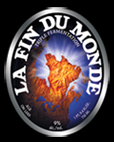 Because our Beer Tasting in March
went over so well, we've decided to make it permanent.
We will now have a monthly beer tasting and a Beer of
the Month! Because our Beer Tasting in March
went over so well, we've decided to make it permanent.
We will now have a monthly beer tasting and a Beer of
the Month!
Unibroue's
La Fin du Monde
$2.50/bottle |
Upcoming
Events!
|

| | |
|
Save 25% 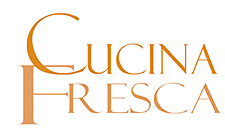
|
The Easter Bunny has arrived at our
store and has left all kinds of special items and treats for
you to discover! To help you help the Easter Bunny,
we're offering this coupon. So hop on over!
Present this
coupon to receive 25% off any Easter-themed
merchandise.
|
|
Offer Valid March 19, 2009
through April 11, 2009 |
Save 25% 
|
SPRING FLING
SALE
Present this coupon and
draw from our Basket of Easter Eggs to receive up to 25% off
your entire purchase.
One coupon per person/per purchase
during the month of April. Cannot be used in combination with
any other promotion, sale or coupon. Excludes purchases of
wine, appliances, or items already on sale.
|
|
Offer valid through April
30, 2009.
|
| April
Events |
|
Cucina Fresca's 1st Annual Kids
Easter Coloring Contest Winner
We had incredible participation in
our 1st Annual Kids Easter Coloring Contest. A special thank
you to all the kids who entered our contest! Each winner
receives a Easter basket filled with goodies from Cucina
Fresca.
Here are the winners:
Age 0-2 Winner: Joe
Riordan
Age 3-5
Winner: Kate Holmes
Age 6-8 Winner: Kyleigh
Novacek
Age 9-12
Winner: Josey Robinson
Congratulations!
Please come by anytime to collect your Easter
basket! |
Butter
Basics
|
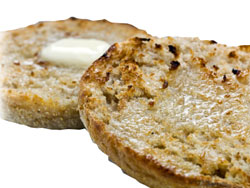 "Bread is but a canvas for good
butter." Historically, butter was peasant food just as
bread was. It was natural that they become inextricably
linked. "Bread and butter" is a time-honored idiom for
describing one's source of daily livelihood and well-being.
Somewhere along the line, French aristocracy discovered the
pleasures of butter transforming it to a much-in-demand food
staple and key to many gastronomic favorites. "Bread is but a canvas for good
butter." Historically, butter was peasant food just as
bread was. It was natural that they become inextricably
linked. "Bread and butter" is a time-honored idiom for
describing one's source of daily livelihood and well-being.
Somewhere along the line, French aristocracy discovered the
pleasures of butter transforming it to a much-in-demand food
staple and key to many gastronomic favorites.
What is Butter? - For being a
staple of kitchens everywhere, you may be amazed about what
you don't know about butter. Butter is made from milk,
most commonly cow's milk, but can be made from sheep, goat,
buffalo, yak, or other ruminating mammals' milk. Butter
is comprised of butterfat, milk proteins, and water.
According to legal food definitions, commercially produced
butter must have a butterfat content of at least 80%.
Cow's milk has a butterfat content of approximately 4%, so it
takes a lot of milk to make a pound of butter, in fact 10-11
quarts.
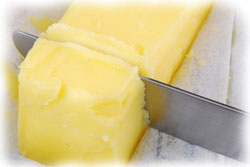 How Butter is Formed --
Suspended in unhomogenized milk, the butterfat exists in tiny
fat "bubbles" with a thin membrane surrounding each globule of
fat. Undisturbed, the fat or cream, rises to the top of the
milk and is easily skimmed away to the butter churn. Agitating
the skimmed cream will turn it into butter. This agitation, or
churning, breaks the membranes of the fat globules allowing
them to form longer chains of fat "crystals" and coagulating
in the process. Churned butter is comprised of these butterfat
crystals, loose butterfat, and unbroken fat globules. The
percentage of each form of butterfat will have an impact on
the consistency of the butter. As butter forms, liquid
separates from the fat. This liquid is known as
buttermilk. (However, most commercially-sold buttermilk is a
fermented skim milk, not the runoff from
butter-making). How Butter is Formed --
Suspended in unhomogenized milk, the butterfat exists in tiny
fat "bubbles" with a thin membrane surrounding each globule of
fat. Undisturbed, the fat or cream, rises to the top of the
milk and is easily skimmed away to the butter churn. Agitating
the skimmed cream will turn it into butter. This agitation, or
churning, breaks the membranes of the fat globules allowing
them to form longer chains of fat "crystals" and coagulating
in the process. Churned butter is comprised of these butterfat
crystals, loose butterfat, and unbroken fat globules. The
percentage of each form of butterfat will have an impact on
the consistency of the butter. As butter forms, liquid
separates from the fat. This liquid is known as
buttermilk. (However, most commercially-sold buttermilk is a
fermented skim milk, not the runoff from
butter-making).
Why is
Butter Yellow? -- The taste and yellow color of butter
derive much of their character from the pasture or feed given
the dairy animal. Nuances in taste between different dairies
can be quite noticeable and vary by farming region. Many
commercial dairies add annatto, (a seed from the achiote tree)
or beta-carotene, (a natural plant pigment), to their butter
to amplify its yellow appearance.
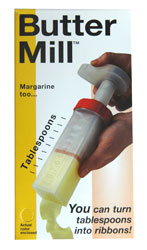 Butter Terms - The most
common butter term is "sweet cream
butter." Sweet cream butter is made from
pasteurized milk and contrasts with butter made from
unpasteurized forms of butter known as "raw cream
butter." In Europe, cultured
butter, where the cream has soured or fermented before
churning, is preferred. Whipped
butter is mechanically fluffed with nitrogen gas to be
more spreadable. Nitrogen gas is used to reduce the
chances of oxidation and spoilage that natural air might
incite. Butter commonly comes as salted
butter or unsalted
butter. Salt serves to preserve butter and enhance its
flavor, while unsalted butter allows the cook to adjust the
salt according to taste. Most baking recipes call for unsalted
butter and calibrate the amount of salt required in the recipe
on that assumption. Butter Terms - The most
common butter term is "sweet cream
butter." Sweet cream butter is made from
pasteurized milk and contrasts with butter made from
unpasteurized forms of butter known as "raw cream
butter." In Europe, cultured
butter, where the cream has soured or fermented before
churning, is preferred. Whipped
butter is mechanically fluffed with nitrogen gas to be
more spreadable. Nitrogen gas is used to reduce the
chances of oxidation and spoilage that natural air might
incite. Butter commonly comes as salted
butter or unsalted
butter. Salt serves to preserve butter and enhance its
flavor, while unsalted butter allows the cook to adjust the
salt according to taste. Most baking recipes call for unsalted
butter and calibrate the amount of salt required in the recipe
on that assumption.
Butter's Nutrition - This is
a bit of a sore subject. Butter is 80% fat; one
tablespoon of butter contains 11 grams of fat, of which 64%,
or 7 grams is saturated fat. It's this saturated fat
component that prompts us for some cautious moderation. One
strategy in balancing our intake of butter is to save it for
when it really counts -- where the flavor of butter is central
to the food experience. Other butter management
strategies include using whipped butter, or compound butters
made of olive oil and butter.
How to Store Butter - Butter
may be kept for several months under refrigeration and for up
to six months in the freezer. To prevent the butter from
picking up odors during storage, wrap it well. Butter, like
all food fats, can become rancid. 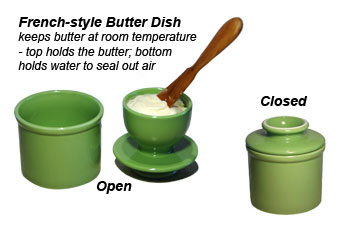 Rancidity occurs over time upon
exposure to air and light; the long fat molecule chains break
apart into smaller fat chains and undesirable acids. Rancid
fat is not unsafe to eat, but will not taste very good.
However, refrigerated butter is not very spreadable. A French
butter dish allows butter to sit at room temperature for
several days without exposure to air. The two part dish
utilizes water to form an airtight seal, thus reducing the
rate of butter's degradation. With these unique butter pots
spreadable butter is always
available! Rancidity occurs over time upon
exposure to air and light; the long fat molecule chains break
apart into smaller fat chains and undesirable acids. Rancid
fat is not unsafe to eat, but will not taste very good.
However, refrigerated butter is not very spreadable. A French
butter dish allows butter to sit at room temperature for
several days without exposure to air. The two part dish
utilizes water to form an airtight seal, thus reducing the
rate of butter's degradation. With these unique butter pots
spreadable butter is always
available!
|
Butter and Yolk
Sauces
|
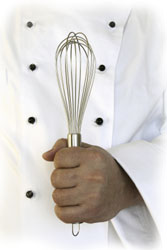 The pantheon of sauces is vast!
Sauces are often what transform the ordinary into
extraordinary. But, we often assume that sauces are best left
to the experts and that they are beyond the scope of the
everyday kitchen. This, of course, is not true! The pantheon of sauces is vast!
Sauces are often what transform the ordinary into
extraordinary. But, we often assume that sauces are best left
to the experts and that they are beyond the scope of the
everyday kitchen. This, of course, is not true!
There
are basic families of sauces from which an endless variety of
other sauces emerge. We'll explore a few of these sauces that
depend on butter and learn some of the science behind what
makes these sauces work.
One prominent family of
sauces featuring butter is the Hollandaise family.
Sauces in this group combine egg yolks, some acidic component,
and butter into a topping that has both visual and flavor
appeal. Once you learn the basics of Hollandaise, the
techniques transfer to the related sauces.
Making Hollandaise Sauce -
This classic sauce coaxes together liquids, oil and water,
that would not normally mix. This combining process is known
as emulsification. It begins by melting one cup of butter and
keeping it quite warm. Combine three egg yolks and one
tablespoon of lemon juice in a heavy saucepan. Heat and whisk
the yolk mixture gently just until it begins to thicken. Drip
in a small amount of the hot, melted butter while continually
whisking. Continue to drizzle in the butter and stir until all
of the butter is incorporated. Remove from heat. A well-made
Hollandaise will keep for about 30 minutes before
serving.
Sauce Secrets
for a Great Hollandaise:
- Mind the Temperatures - Start with a cold saucepan, cold
yolks, and cold lemon juice. Apply heat very gradually.
- Stir diligently - Throughout the process, stir the sauce
continually with a whisk taking care to catch the edges and
corners of the pan.
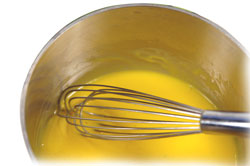 Add the warm, melted butter just
as the yolks are beginning to thicken. Too early and the
thickening will be slowed; too late and the yolks may curdle
or scramble. Add the warm, melted butter just
as the yolks are beginning to thicken. Too early and the
thickening will be slowed; too late and the yolks may curdle
or scramble.
- Add the warm butter gradually, especially at the
beginning. The egg yolks act as an emulsifier for combining
the water-based juice with the oil-based butter; give them a
chance to do their work.
- Some instructions for Hollandaise sauce call for
reserving two tablespoons of cold butter. Add the first cold
tablespoon to the yolk mixture at the start of
heating. The cold butter moderates the heat
application to the yolks. When the cold chunk of
butter is completely melted and incorporated into the egg
yolks, the remaining hot,melted butter may be drizzled in.
Use the second cold tablespoon of butter to cool down the
sauce at the very end.
- If the Hollandaise Sauce separates prior to serving,
this may be the result of applying too much heat, adding the
butter too quickly, or using too much butter. If the sauce
is just beginning to separate you may be able to heal it
with the addition of a tablespoon of cold water or cold
cream.
Variations in
the Hollandaise Family of Sauces - From this basic
sauce wonderful variations are available:
Sauce
Maltaise - This sauce adds one tablespoon of orange
juice along with the lemon juice in the egg yolk
mixture. An additional 3-4 tablespoons of orange juice
and a teaspoon of orange zest are whisked into the completed
sauce. 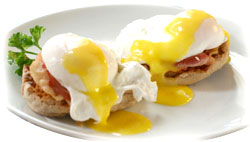 Béarnaise
Sauce Béarnaise
Sauce - In this sauce, the lemon juice is replaced with
a reduction of white wine vinegar laced with finely chopped
shallots and tarragon. The result is a richly flavored sauce
that complements meat, chicken, fish, and egg dishes. Sauce
Choron - To the basic Béarnaise Sauce, add 2-3
tablespoons of tomato paste before serving. This variation is
also great with meat, chicken, fish and egg
dishes.
|
Roux-based
Sauces
|
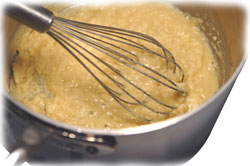 White sauces, another classic family of
sauces, begin with a mixture of flour and butter with
different liquids and flavorings added for a wealth of
possibilities. White sauces, another classic family of
sauces, begin with a mixture of flour and butter with
different liquids and flavorings added for a wealth of
possibilities.
A basic white sauce begins with four
tablespoons of butter melted in a heavy saucepan. Six
tablespoons of flour are added all at once to the melted
butter. Over medium heat, the flour and butter mixture are
continually stirred; this flour and butter mixture is known as
a roux
(rhymes with "boo"). The heat should be strong enough to keep
the roux bubbling, but
not so strong as to turn the mixture brown. Once the roux has cooked, add 2 cups
of very hot milk to the roux all at once and stir
briskly. The sauce will thicken quickly. Season the sauce with
salt and pepper.
Sauce
Secrets for Roux-based
Sauces:
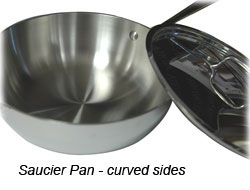 Cook and stir the roux for a full 2 minutes
before adding the liquid. During those two minutes, a
chemical reaction takes place that eliminates any raw, pasty
taste in the flour. Don't rush this step. Cook and stir the roux for a full 2 minutes
before adding the liquid. During those two minutes, a
chemical reaction takes place that eliminates any raw, pasty
taste in the flour. Don't rush this step.
- Use a stainless steel or enameled saucepan with curved
edges, also known as a saucier pan. The sloped sides of the
pan make it easy to whisk and stir without any of the roux getting stuck in the
corner of the pan and scorching.
- Heating the liquid to be added to a near boil will help
prevent any lumps in the resulting sauce. If lumps should
appear, whisk vigorously. If persistent, strain the sauce
through a fine sieve.
Variations in the Roux-based
Family of Sauces - From
this basic white sauce many versatile variations are
available:
Béchamel
Sauce - This sauce is the classic white sauce where the
liquid is milk. As a "mother sauce" it provides the basis for
many other sauces. One variation calls for half beef stock and
half milk for the liquid portion of the sauce.
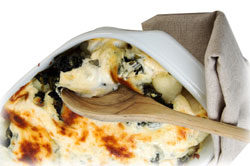 Mornay
Sauce - To the
basic white sauce, grated cheese is added, half Gruyère and
half Parmesan. The sauce is often served with seafood,
vegetables, or as the base for a gratin. Mornay
Sauce - To the
basic white sauce, grated cheese is added, half Gruyère and
half Parmesan. The sauce is often served with seafood,
vegetables, or as the base for a gratin.
Sauce
Soubise - Onions (4 cups) are wilted in the butter
before the roux's flour is added. At the finish, the sauce is
pureed to smoothness. Add a few tablespoons of cream as the
sauce is reheated, and you'll have a sublime
result.
|
Q &
A's
|
 Q: What is clarified
butter? What is ghee? Q: What is clarified
butter? What is ghee?
A: Clarified
butter is nearly pure butterfat. Butter is melted separating
its components into butterfat, water, and milk proteins. The
foamy white particles formed from the milk proteins are
skimmed away leaving the pure butterfat, or clarified butter.
Ghee, popular in Indian cooking, is clarified butter that has
been heated to 250° F evaporating any residual water and
turning the milk proteins a golden color. The "toasted" milk
proteins are removed from the butterfat, but leave behind a
delicious nutty flavor. Click this link to view a mini-video of How to Clarify Butter.
(Courtesy of the Wisconsin Cheese Board).
Q: What is the proper way to
eat butter at the dining table?
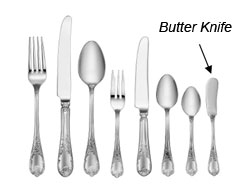 A: Butter at the dining
table takes on a "condiment" role. Butter may be placed
individually at each place setting, or served to diners from a
common dish. At formal dinners, a butter knife will be a
part of each place setting; it is a petite knife without sharp
edges. When served bread, take a portion of butter from
the common dish and place on the side of your bread
plate. Break off a small, bite-sized portion of bread
and using your butter knife, place butter on that piece
only. Never slather a whole piece of bread with butter
at one time, and do not create a "butter sandwich." "One bite
at a time" is proper bread and butter etiquette. A: Butter at the dining
table takes on a "condiment" role. Butter may be placed
individually at each place setting, or served to diners from a
common dish. At formal dinners, a butter knife will be a
part of each place setting; it is a petite knife without sharp
edges. When served bread, take a portion of butter from
the common dish and place on the side of your bread
plate. Break off a small, bite-sized portion of bread
and using your butter knife, place butter on that piece
only. Never slather a whole piece of bread with butter
at one time, and do not create a "butter sandwich." "One bite
at a time" is proper bread and butter etiquette.
Q: What is brown
butter?
A: Brown butter, or
beurre noisette, is a classic chef's secret for creating
fantastic flavor. Cold butter is melted and allowed to
barely simmer over heat. The milk proteins will produce
a white foam on top. As the milk proteins "cook" they
will brown and sink to the bottom. When the top foam of
the butter is a light brown, remove from heat and allow it to
cool. Strain the golden butter to remove any browned protein
particles, then use as a simple sauce or sauce component. The
"browning effect" of the heated proteins produces a
wonderfully nutty flavor. Click this link to view a mini-video of How to Brown Butter. (Courtesy
of the Wisconsin Cheese
Board).
|
Cookbook
Review
|
The
Silver Palate Cookbook, 25th Anniversary Edition by
Julee Russo and Sheila Lukins. Published by Workman
Publishing Company, Inc., New York, NY. Copyright
2007.
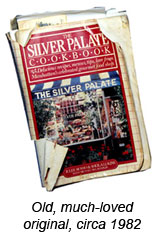 We're always intrigued with the latest
cookbook, but we often come back to the classics. How
does a cookbook become a classic? It stands the test of
time and produces reliable results again and again. A
favorite cookbook will show the marks of true love -- the
pages become tattered, perhaps a few splatters marks, or
corners dogged-eared. The original Silver
Palate Cookbook is one of those books in our
kitchen. We're always intrigued with the latest
cookbook, but we often come back to the classics. How
does a cookbook become a classic? It stands the test of
time and produces reliable results again and again. A
favorite cookbook will show the marks of true love -- the
pages become tattered, perhaps a few splatters marks, or
corners dogged-eared. The original Silver
Palate Cookbook is one of those books in our
kitchen. 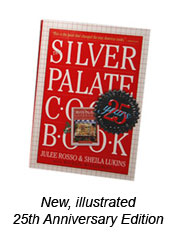 We're so pleased that Julee Russo and
Sheila Lukins have decided to update their classic with The
Silver Palate, 25th Anniversary Edition. The Silver
Palate Cookbook grew out of their successful catering
business and contains basics, but so much more. This cookbook
has introduced countless individuals to the enjoyment of
cooking one's own food, and the ease with which good-tasting,
good-looking food can be assembled. The sidebars of each
page are generously populated with tips and hints about the
recipe, or perhaps about entertaining, or some fascinating
back story. If you missed The Silver Palate the first
time around, the 25th Anniversary Edition is ready for you
now. You'll quickly understand why this cookbook has
earned the reputation of
"classic!" We're so pleased that Julee Russo and
Sheila Lukins have decided to update their classic with The
Silver Palate, 25th Anniversary Edition. The Silver
Palate Cookbook grew out of their successful catering
business and contains basics, but so much more. This cookbook
has introduced countless individuals to the enjoyment of
cooking one's own food, and the ease with which good-tasting,
good-looking food can be assembled. The sidebars of each
page are generously populated with tips and hints about the
recipe, or perhaps about entertaining, or some fascinating
back story. If you missed The Silver Palate the first
time around, the 25th Anniversary Edition is ready for you
now. You'll quickly understand why this cookbook has
earned the reputation of
"classic!"
|
Recipes with Basic
Sauces
|
Recipes excerpted from the
Silver
Palate Cookbook 25th Anniversary Edition by Julee Rosso and Sheila Lukins.
Copyright 2007. Used by permission of Workman Publishing Co.,
Inc. New York, NY. All Rights Reserved.
Hollandaise
Sauce with
Spring Asparagus
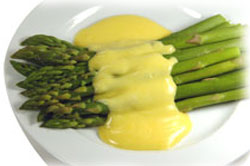 Hollandaise Sauce is a perfect
complement to spring's early vegetables - asparagus and
artichokes - or drizzled on top of fish. Of course, a good
Hollandaise tops the classic brunch dish, Eggs Benedict.
Deploy this sauce on any occasion calling for a buttery, lemon
flavor! Hollandaise Sauce is a perfect
complement to spring's early vegetables - asparagus and
artichokes - or drizzled on top of fish. Of course, a good
Hollandaise tops the classic brunch dish, Eggs Benedict.
Deploy this sauce on any occasion calling for a buttery, lemon
flavor!
Click here to view the
recipe.
Click here for a
printable
version of the recipe
(PDF
format).
Béarnaise
Sauce with Filet of Beef
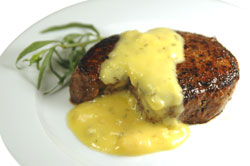 In our early days of cooking, this
sauce was the one that introduced us to the wonderful flavors
of tarragon. The delicate herb, the piquant white wine
vinegar, and aromatic shallots, awaken the palate preparing it
for the full flavors of that which it graces. The
classic pairing of Tenderloin of Beef with Béarnaise Sauce is
a worthy place to begin your appreciation of this
sauce. In our early days of cooking, this
sauce was the one that introduced us to the wonderful flavors
of tarragon. The delicate herb, the piquant white wine
vinegar, and aromatic shallots, awaken the palate preparing it
for the full flavors of that which it graces. The
classic pairing of Tenderloin of Beef with Béarnaise Sauce is
a worthy place to begin your appreciation of this
sauce.
Click here to view the
recipe.
Click here for a
printable
version of the recipe
(PDF
format).
Béchamel
Sauce in Vegetarian Spinach Lasagna
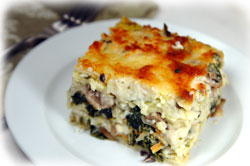 True to its tagline, Béchamel
Sauce is a "mother sauce." This sauce begins with a
butter-flour roux and becomes a silky, smooth white sauce that
can be transformed into any number of flavorful
variations. With this Vegetarian Spinach Lasagna, the
Béchamel Sauce takes the place of the red sauce found in
traditional lasagna. Richly-flavored with onions and
mushrooms, and brightly-colored with spinach and grated
carrots, this lasagna is a hearty and satisfying do-ahead
meal. True to its tagline, Béchamel
Sauce is a "mother sauce." This sauce begins with a
butter-flour roux and becomes a silky, smooth white sauce that
can be transformed into any number of flavorful
variations. With this Vegetarian Spinach Lasagna, the
Béchamel Sauce takes the place of the red sauce found in
traditional lasagna. Richly-flavored with onions and
mushrooms, and brightly-colored with spinach and grated
carrots, this lasagna is a hearty and satisfying do-ahead
meal.
Click here to view the
recipe.
Click here for a
printable
version of the recipe
(PDF
format).
|
Bridal
Registry
|
Wedding
season in quickly approaching. Join us in celebrating the
engagements and pending nuptials for the following couples
registered at Cucina Fresca in 2009:
Ruth
Meyer and Tim Feldman
Wedding Date: June 27th
2009
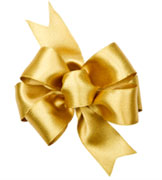 Victoria Nalywaiks and
Nicholas Richardson
Shower Date: June
5th, 2009
Wedding Date: July 4th, 2009
Korrie Vance
and Shaun Hornbarger
Wedding Date: July
18th 2009
Holly
Gilbertson and Brett Hoffman
Wedding
Date: August 15th 2009
Wedding Registry
List is available on our
website! | |
Add some
sauce to your life!
|
|
| |